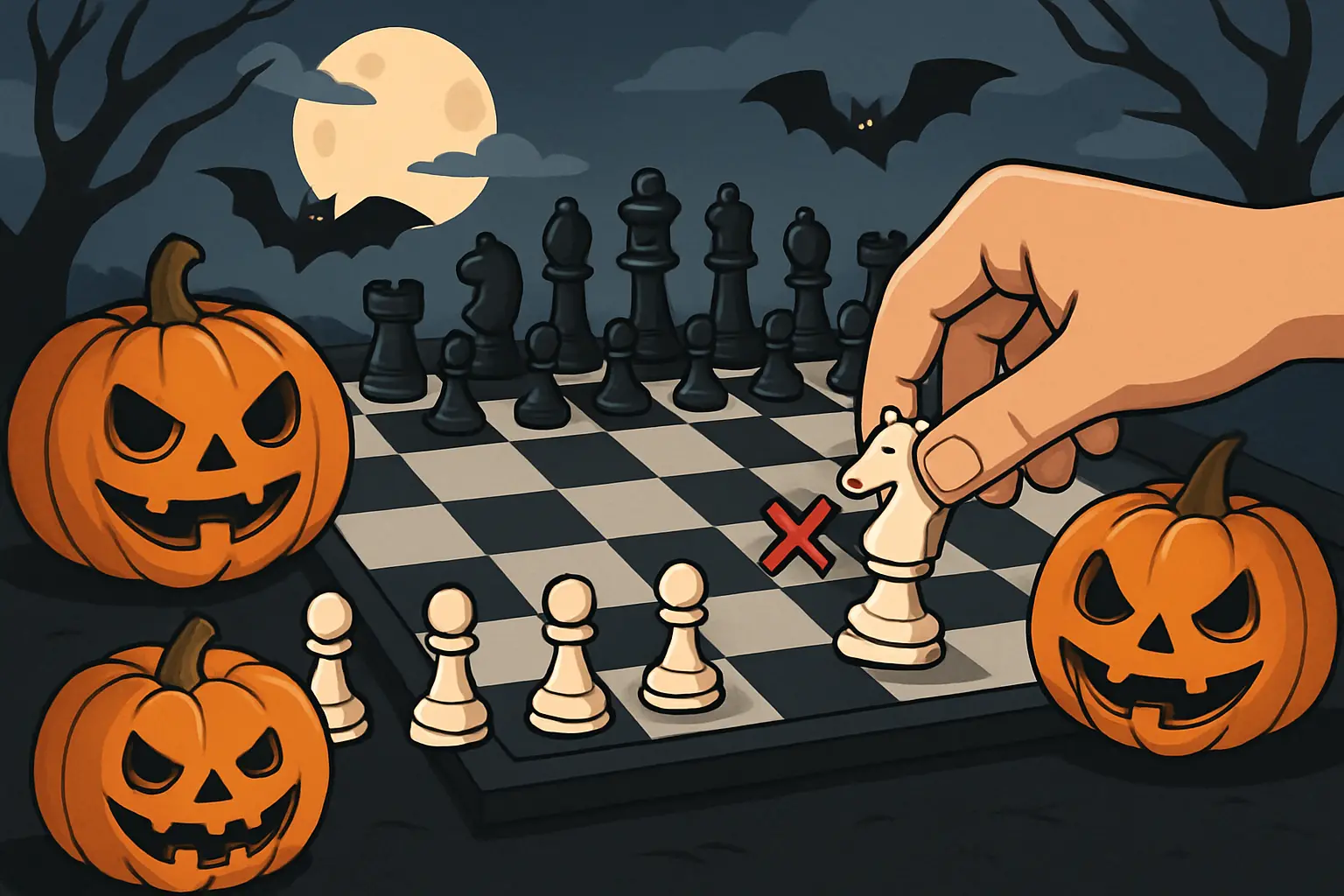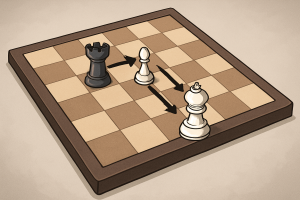Call us now:

There’s a particular electricity that runs through the board when a player puts down their knight on e5 in the Four Knights. A tiny pause follows, the kind that usually precedes either a joyful miniature or a long, disciplined defense. If you’ve ever sprung the Halloween Gambit—also called the Müller–Schulze Gambit—you know that feeling. Knights are chased back to the first rank, pawns jump forward like wildfire, and the center becomes a battlefield where courage matters as much as calculation. It’s loud, it’s provocative, and when the season comes around and pumpkin lanterns appear in windows, this opening reliably brings a spike of activity in online databases, studies, and YouTube tutorials.
I’ve played and prepared the Halloween Gambit for students who wanted a practical weapon, and I’ve shown others how to dismantle it with clinical precision. This guide is the one-page masterclass you need: crisp move orders, the best Halloween Gambit lines, traps that actually happen, a balanced Halloween Gambit theory breakdown, and the clearest Halloween Gambit refutation plans grounded in engine-backed evaluation. Whether you’re looking to ride the initiative with White or squeeze it dry with Black, settle in.
What is the Halloween Gambit? Origins and name
The Halloween Gambit arises from the Four Knights Game: e4 e5 openings that start symmetrically and invite classic development. The exact position appears after:
1. e4 e5
2. Nf3 Nc6
3. Nc3 Nf6
4. Nxe5!?
White’s last move looks outrageous to principled players: a knight charges into the center to take a pawn, inviting 4…Nxe5. After 5 d4, the idea is revealed—White pushes d d4 and e5, chases Black’s knights to poor squares (sometimes all the way back to g8 and g6), and grabs a large central space advantage with initiative and tempi. You trade the structural “correctness” of classical development for immediate pressure and chaos.
The name “Halloween” fits perfectly, not because of a date, but because the early pawn storm “scares” Black’s knights backward. In many of the best Halloween Gambit lines for White, Black’s kingside knight retreats to g8, and in some cases both knights are forced into humiliating positions while White swarms the board. The alternative name Müller–Schulze Gambit honors German analysts who explored these ideas in depth and circulated the gambit in club play.
Exact move order and main ideas (for both sides)
This is the Four Knights Game Halloween Gambit. Think of it as a tuned engine: if you know the move order nuances, you’ll get more mileage than an opponent who just “knows it’s bad.”
Move order: the core line
1. e4 e5
2. Nf3 Nc6
3. Nc3 Nf6
4. Nxe5 Nxe5
5. d4
White spends a tempo to knock Black’s knight around and leverages central space. The two most important replies:
- 5…Ng6 (main line, best practical choice for Black)
- 5…Nc6? (a common inaccuracy that hands White a free initiative)
Less frequent but noteworthy:
- 5…Neg4?! (invites complications)
- 5…Bb4!? (a sideline trying to create counterplay)
- 4…Qe7 (declining the gambit at move four)
White’s main ideas
- Space avalanche: Push d4 and e5 to harass the knights, gain tempi, and lock in a strong central space advantage.
- Development before material: After gaining space, bring pieces to active squares—Bc4, Qe2, Be3 or Bg5, long castle, and rooks on the e- and d-files. You play for initiative and time.
- Attack patterns: Typical patterns include Bc4 on the a2–g8 diagonal, Qf3 or Qe2 hitting f7, h4–h5 space grabs against a knight on g6, and sacrificial ideas on e6 or f7 if Black drifts.
- Don’t overextend: A central shell without backup can crack. If Black gets in …d5 and …c6 with smooth development, your initiative fades.
Black’s main ideas
- Accept and neutralize: The principled path is 4…Nxe5 5 d4 and then 5…Ng6. Retreating to g8 looks ugly but is solid—Black intends …d5, …c6, …Be6, …Qd7, and flexible castling.
- Structural repairs: You’ll often return White’s time advantage by nailing the center with …d5 or provoking overextensions that can be attacked later.
- Don’t get greedy: Trying to refute the gambit in one bite with tactical tricks and loose piece play can backfire. Keep it compact, trade into a favorable middlegame, and let White’s space become a target.
- The anti-Halloween: Declining with 4…Qe7 is possible and fairly clean; it takes the sting out and steers toward calmer waters.
Halloween Gambit lines: accepted vs declined
Accepted: 4…Nxe5 5 d4 Ng6 (main line)
This is the heartbeat of Halloween Gambit theory. After:
1. e4 e5 2. Nf3 Nc6 3. Nc3 Nf6 4. Nxe5 Nxe5 5. d4 Ng6 6. e5
Black has two principal retreats:
- 6…Ng8 (the solid “swallow the pride” retreat)
- 6…Ng4?! (sharper and riskier; White gets extra tempos with h3 and Qxg4 motifs)
After 6…Ng8, White typically continues 7. Bc4 (or 7. h4) and castles long. A very thematic plan is:
7. Bc4 d5 8. Bxd5 c6 9. Be4 Bb4 10. O-O N8e7
Black holds the center and prepares …O-O or …O-O-O. Engines like Black here if he’s precise, but from a practical point of view White’s position is easier to play: the moves flow, and the threats are straightforward. That’s what makes the gambit such a strong surprise weapon below master level.
Critical notes for Black:
- …d5 is your liberating move. If you can coordinate …d5 and …c6 without getting mated, you’re fine.
- …Qd7 and …O-O-O often coordinate well with …Be7–g5 trades and …f6 breaks.
- Keep an eye on e6 and f7. If you can prevent sacrifices there, most of White’s sting is gone.
Accepted but inaccurate: 5…Nc6? and the chase
A common misstep is 5…Nc6?! after 5 d4. White then gets:
6. d5 Ne7 7. e5
Black’s knights have been pushed back, and White’s pawns dominate space. The plan writes itself: Bc4, Qe2, 0-0-0, and either f4–f5 or h4–h5 depending on Black’s setup. Engines tolerate Black’s position only with perfect counterplay—most human games tilt toward White’s attack.
Accepted, sharp sideline: 5…Neg4?!
After 5 d4 Neg4?! 6 e5, Black can stumble fast. For example:
6…Qe7 7 Be2 Nxe5 8 dxe5 Qxe5 9 O-O
White develops with tempo, and Black’s king is stuck. If Black’s coordination falters, Bf3 and Re1 hit the queen, and a quick Qd3 or Re1 can create tactical overload.
Declined: 4…Qe7
Declining the Halloween Gambit is sensible. After 4…Qe7 5 Nf3 Nxe4? can be met strongly by Qe2 or Qe2/Qe2-d3 ideas, and Black must still watch the center. The cleanest anti-Halloween setup with 4…Qe7 is:
1. e4 e5 2. Nf3 Nc6 3. Nc3 Nf6 4. Nxe5 Qe7 5. Nf3 Nxe4 6. Be2 Nxc3 7. dxc3 d6
Black avoids getting chased and steers toward a small pull. This isn’t a crowd-pleaser, but it works well for those who prefer structure over tactics.
Best practical lines for White (by rating band)
Below are distilled plans that I’ve used with students to harvest points with the Halloween Gambit. Use them as a repertoire outline, not as memorization fodder.
For beginners
- Move order focus: 1 e4 e5 2 Nf3 Nc6 3 Nc3 Nf6 4 Nxe5 Nxe5 5 d4. If 5…Ng6, play 6 e5 Ng8 7 Bc4. Think development and king safety: castle long quickly.
- Piece placement: Bc4, Qe2, Be3 or Bg5, long castle. Rooks to d1 and e1.
- Attack hooks: h4–h5 if Black has a knight on g6; f4–f5 if Black delays …d5. If Black castles short, look for Bxf7+ shots or e6 breaks.
- Avoid: Pointless pawn pushes like a3 or h3 when they aren’t needed. The center is your treasure—don’t loosen it early with d5 unless you’ve calculated a favorable transformation.
For intermediate players
- Know the mainline backbone:
1. e4 e5 2. Nf3 Nc6 3. Nc3 Nf6 4. Nxe5 Nxe5 5. d4 Ng6 6. e5 Ng8 7. Bc4 d5 8. Bxd5 c6 9. Be4
White keeps the diagonal alive and aims for Qf3, 0-0-0, and h4–h5. If Black plays …Bb4+, interpose c3 or Bd2 depending on tactics; avoid allowing …Qh4+ with tempo unless you’ve calculated a response. - Typical squeeze: If Black delays …d5, go 7. h4, 8. h5, push the knight back, castle long, and swing a rook to h3 or g3. Many opponents collapse to a direct kingside attack.
- Weapon vs …Qe7 decline: After 4…Qe7 5 Nf3, prefer calm moves that restore flexibility: Be2, 0-0, Re1, h3, and a later e5 or d5 depending on Black’s setup.
For advanced/club players
- Choose a focal line to master. My practical recommendation against 5…Ng6 is:
1. e4 e5 2. Nf3 Nc6 3. Nc3 Nf6 4. Nxe5 Nxe5 5. d4 Ng6 6. e5 Ng8 7. Bc4 d5 8. Bxd5 c6 9. Be4 Be6 10. O-O Qd7 11. f4 N6e7 12. Be3 Nf5 13. Bf2 h5
This structure offers White attacking edges and keeps practical questions on the board. Engines still say Black is fine, but human defense here is not trivial—especially if the clock is running. - Punish 5…Nc6?! with 6 d5 Ne7 7 e5 and score. Convert by increasing pressure on f7 with Bc4, Qf3/Qe2, and a rook lift if the position allows.
- Recognize when to trade off: Strong Halloween Gambit players know when the storm is over. If Black consolidates and you’ve gained development, trade into positions where your space and better-coordinated pieces persist.
Best defenses and refutations for Black (by rating band)
This is the meat of “how to refute the Halloween Gambit.” The short answer: accept it, play 5…Ng6, return the knight to g8 if needed, and hit back with …d5 and …c6. The long answer follows.
For beginners
- Accept and be humble: 4…Nxe5 5 d4 Ng6 6 e5 Ng8. Put your knight back; it’s okay. You’re not worse.
- Free your game with …d5: Aim for …d5 and …c6 to chip away at White’s center. Develop your dark-square bishop—…Be6 is a great square—and don’t rush kingside castling if the position looks airy.
- Safe structure: Be7, c6, d5, Qd7, 0-0 or 0-0-0. If White castles long and throws pawns, consider 0-0-0 and counter with g5/h5 or opening the center.
For intermediate players
- The standard neutralization (recommended):
1. e4 e5 2. Nf3 Nc6 3. Nc3 Nf6 4. Nxe5 Nxe5 5. d4 Ng6 6. e5 Ng8 7. Bc4 d5 8. Bxd5 c6 9. Be4 Be6 10. O-O Qd7 11. f4 N6e7 12. Be3 Nf5 13. Bf2 h5
Black’s plan: …h4 in some cases, …Nge7, …O-O-O, and timely …c5. The pawn structure is robust and White’s attack meets resilient counterpunches. - Practical trick: If White delays Bc4, try …Bb4, …d6, or even …Qh4 if there’s no g3. Don’t be tempted by material grabs that leave your king in the center.
- Decline as a repertoire choice: 4…Qe7 is a fine anti-surprise weapon, especially in classical games. You remove the “scary knights retreat” narrative and claim a small, healthy edge.
For advanced/club players
- The engine-guided refutation approach:
After 5 d4 Ng6 6 e5 Ng8, prioritize crystal-clear squares and timing. Aim for:
…d5 early (especially if White hasn’t pinned a knight with Bg5), then …c6, …Be6, …Qd7, and flexible castling. If White spends an early tempo on h4–h5 without development, hit the center with …c5 or …f6 in one go and liquidate. - Important finesse: Against 7. h4, consider …h5 to fix the kingside and neutralize the rook lift idea. The move …N8e7 heading for f5 is often excellent.
- Memorize one practical sequence:
1. e4 e5 2. Nf3 Nc6 3. Nc3 Nf6 4. Nxe5 Nxe5 5. d4 Ng6 6. e5 Ng8 7. h4 d5 8. h5 N6e7 9. Bg5 h6 10. Bh4 c6 11. Bd3 Qb6
Black controls the breaks and is on the cusp of …Bf5 or …Nf5 with queenside safety. The evaluations are kind to Black if you avoid cheap shots on e6/f7.
Accepted vs declined: plans, typical middlegames
Accepted (main line) gives the most dynamic play. White will castle long more often and steer toward a kingside attack. Black typically keeps the king flexible, waiting to see whether to castle long or short based on where White commits. The middlegame themes:
- White
- Attacking f7 and e6 with bishops and queen
- h4–h5 pawn storms if the knight sits on g6
- Rook lifts via h3 or g3
- Space squeezes; don’t let the center evaporate for free
- Black
- …d5 break to challenge the base of White’s center
- …c6 to stabilize d5 and boot a bishop from b5 or c5
- Counter on the queenside if White castles long
- Trade pieces to exploit overextensions
Declined (4…Qe7) often slides into slower play. White keeps a small initiative from having the first move but loses the fast-chase dynamic. This suits Black players who dislike the volatility of the accepted lines.
Common traps and tactical motifs in the Halloween Gambit
You don’t need a trap to win with the Halloween Gambit, but understanding them is language fluency. The gambit has a few recurring motifs that punish carelessness.
- The “knight gridlock” trap:
1. e4 e5 2. Nf3 Nc6 3. Nc3 Nf6 4. Nxe5 Nxe5 5. d4 Nc6? 6. d5 Ne7 7. e5
Black’s knights are tangled, White castles long, and both bishops aim at the kingside. If Black tries …Nfg8 to regroup, h4–h5 is crushingly fast. - The f7 pressure theme:
In many lines after 5…Ng6 6 e5, White threatens Bc4 and Qf3 with Bxf7+ tactics. If Black lazily plays …d6 without calculating, Bxf7+ Kxf7 Qd5+ can win material or force a miserable king walk. - The queen sting on h5:
Sometimes after h4–h5, White’s queen comes to h5 and hits f7 along with a bishop on c4. If Black has moved …g6 early to stop Qh5, e6 sacrifices become thematic. Engines hate it; opponents facing a tight clock often fall for it. - The pin-and-push:
After Bc4 and Bg5, a knight pinned on f6 becomes a tactical liability. White expands with e5–e6 or d5, and suddenly …Qe7 runs into Nd5 forks or Bxf6 followed by Qe2/Qe2–b5+ shots. - The greedy queen trap:
Occasionally, Black grabs a poisoned pawn on d4 with a queen. White answers with Be3, Qe2, Rd1, and a quick Nd5. The queen gets harassed and the initiative roars. If you chase pawns in this opening, you’d better calculate ten moves deep.
Engine-backed theory: critical lines and evaluations
Modern engines like Stockfish and neural networks like Lc0 evaluate the Halloween Gambit with skepticism. With best play, Black is supposed to be a bit better after accepting and playing 5…Ng6. Typical engine evaluations run from about -0.6 to -1.3 in Black’s favor in the most principled lines. That said, the machine’s verdict doesn’t capture the practical voltage of White’s initiative in human games, especially blitz or rapid.
Engine-friendly refutation plan for Black
- Accept: 4…Nxe5 5 d4 Ng6
- Retreat and regroup: 6 e5 Ng8
- Strike the base: …d5 and …c6 as soon as development allows
- Coordinate: …Be6, …Qd7, …N8e7–f5 in many positions
- Castle where safe: If White has castled long and pushed h4–h5, look to castle long only if your queenside is airtight. Otherwise, go short and aim …f6 in one shot.
Engine-friendly plan for White
- Maximize tempi: After 6 e5 Ng8, play Bc4, h4–h5 or Qe2/Qf3, and castle long
- Keep the center elastic: Don’t rush d5 unless you’re certain it opens lines for your pieces
- Set tactical traps on e6/f7: These squares are the heart of your attacking geometry
Is the Halloween Gambit sound?
In strict engine terms, no. It is not fully sound against prepared opposition. Is it playable and dangerous? Absolutely—especially at club levels and in faster time controls. Strong players use it as a practical weapon, banking on the fact that many Black players try to “refute” it actively and end up in a maze of tactical problems.
Halloween Gambit model games to study
Below are annotated PGN-style fragments that show the plans. These aren’t tied to a specific event; they’re distilled from typical master-class play and engine-guided patterns.
Model 1: White storms the kingside
1. e4 e5 2. Nf3 Nc6 3. Nc3 Nf6 4. Nxe5 Nxe5 5. d4 Ng6 6. e5 Ng8 7. Bc4 d6 8. Qf3 Be6 9. Bxe6 fxe6 10. Qxb7 dxe5 11. Qc6+ Kf7 12. dxe5 N8e7 13. Qf3+ Kg8 14. Qe4
White compromises Black’s structure, targets f7, and will castle long. Engines think Black can hold; practical defense is hard.
Model 2: The professional neutralization (Black’s side)
1. e4 e5 2. Nf3 Nc6 3. Nc3 Nf6 4. Nxe5 Nxe5 5. d4 Ng6 6. e5 Ng8 7. h4 d5 8. h5 N6e7 9. Bg5 h6 10. Bh4 c6 11. Bd3 Qb6 12. Qd2 Bf5 13. O-O-O O-O-O
Black has perfect anti-Halloween coordination. White’s attack is spent; the center and queenside favor Black in the long term.
Model 3: Punishing 5…Nc6?!
1. e4 e5 2. Nf3 Nc6 3. Nc3 Nf6 4. Nxe5 Nxe5 5. d4 Nc6? 6. d5 Ne7 7. e5 Nfg8 8. d6 cxd6 9. exd6 Nf5 10. Qe2+ Be7 11. Nb5 Kf8 12. Bf4
White’s space and development crush Black’s uncoordinated camp. Even with perfect play, Black walks a tightrope.
Model 4: The long castle launch
1. e4 e5 2. Nf3 Nc6 3. Nc3 Nf6 4. Nxe5 Nxe5 5. d4 Ng6 6. e5 Ng8 7. Bc4 d6 8. Qe2 Qe7 9. f4 dxe5 10. dxe5 c6 11. Be3 Nh6 12. O-O-O Bg4 13. Qf2 Bxd1 14. Rxd1
White’s position harmonizes. Black must thread needles to avoid a kingside collapse.
Side-by-side plan and decision tree
Short decision tree for both sides in the most common move orders.
- If you’re White and Black plays 5…Ng6:
- Continue 6 e5. If 6…Ng8, play 7 Bc4 or 7 h4 and plan long castling.
- If Black plays …d5, consider Bxd5 c6 Be4 and castle long, then f4–f5.
- If Black delays …d5, push h4–h5 and aim Qf3/Qe2 with Bc4.
- If you’re White and Black plays 5…Nc6?!:
- Hit 6 d5 Ne7 7 e5. Bring Bc4, Qe2/Qf3 and castle long. You’re better if you don’t blunder.
- If you’re Black and you accept:
- Choose 5…Ng6, 6…Ng8. Play …d5, …c6, …Be6, …Qd7, and only then decide your castling.
- If you’re Black and you decline with 4…Qe7:
- Aim for …Nxe4 only with calculation. Otherwise develop classically, leave White without the chase, and enjoy a small pull.
Table: White plan vs Black plan at a glance
| Scenario | White Core Plan | Black Core Plan |
|---|---|---|
| After 5…Ng6 (Accepted Main) | e5, Bc4, Qe2 or Qf3, long castle, h4–h5, f4–f5; tactical eyes on e6/f7. | …Ng8, …d5, …c6, …Be6, …Qd7, develop smoothly; choose …O-O or …O-O-O based on White’s commitment. |
| Vs 5…Nc6?! (Black Inaccuracy) | d5, e5; big space. Attack with Bc4, Qe2/Qf3, 0-0-0. | Avoid this move. If played, immediate defense and seeking counterplay. |
| Vs early h4–h5 by White | (If Black has knight on g6) | Consider …h5 to fix the structure; then …N8e7–f5 and …c5/…f6 to break the center. |
Common mistakes in the Halloween Gambit
For White
- Overpushing without backup: If you’ve played e5 and d4, don’t toss in d5 or h5 unless it opens lines for your pieces. Empty pawn storms lose games.
- Delaying development: You can’t attack with one bishop and a queen. Get the pieces out. A late Be3/Bg5 or rook to e1/d1 matters more than a third pawn move.
- Forgetting king safety: Long castling is strong, but not obligatory. If Black has already opened the c-file, think twice.
For Black
- Refuting it “on the board” with greed: The gambit punishes arrogance. Take the positional route and you’ll be fine.
- Castling into a storm without development: If you castle short when your dark-squared bishop and knight aren’t coordinated, Qf3 and Bc4 will make you regret it.
- Playing …Nc6 too early after 5 d4: It feeds White the exact chase he wants.
Halloween Gambit vs Belgrade Gambit: key differences
Both lines belong to the Four Knights family (ECO C47), and both thrill attackers, but they are strategically distinct.
- Halloween Gambit: 4 Nxe5 Nxe5 5 d4 with a central pawn storm that drives knights backward. You invest in time and space and usually castle long with an immediate kingside push. Initiative over structure.
- Belgrade Gambit: 4 d4 exd4 5 Nd5. White sacrifices a pawn for rapid development and direct piece play—Nc3-d5 hits c7 and f6, Bf4/Bg5, and 0-0 with pressure on the e-file. It’s less about chasing knights and more about tactical piece activity and squares.
If you love the feeling of pawns bulldozing the board and the visual of knights retreating, the Halloween suits you. If you prefer piece-driven tactics and central tension with fewer pawn advances, the Belgrade is your lane.
Halloween Gambit on lichess, Chess.com, and beyond
On Lichess, you’ll find community studies titled “Halloween Gambit” with embedded PGNs and engine-backed branches that go deep into accepted and declined lines. Chess.com’s explorer provides practical statistics by rating; you’ll notice Halloween popularity spikes in online blitz, and win-rates are extremely sensitive to move order accuracy. Chessable courses and YouTube videos tend to emphasize Halloween Gambit traps and quick knockouts—fun, instructive, and a good supplement, but pair them with a solid refutation plan if you’re playing Black in serious games.
Halloween Gambit with d4 ideas: the heart of the system
Everything starts with d4. If you cannot get d4 in with tempo and you’re forced to play positionally without it, your Halloween is already fading. The best lines hinge on d4–e5 working together:
- d4 gains tempo on a knight.
- e5 gains more tempo and robs Black of harmonious development.
- Only then do you swing pieces and choose where to castle.
Once d4 and e5 are on the board and the knights are awkward, every move you make should ask a question: does this keep the center intact, and does it bring another attacker? If the answer is “no” to both, it’s probably a tempo you can’t afford.
Halloween Gambit stockfish evaluation: the sober truth
When both sides navigate the main line accurately, Stockfish and peers give Black a small but stable edge. The conventional engine narrative is:
- After 5…Ng6 6 e5 Ng8, Black’s structure is healthy, and if …d5 and …c6 land, the advantage grows.
- White can maintain enough pressure to keep the position practical, but not enough to objectively equalize without cooperation.
That verdict doesn’t mean the gambit is useless—it means you need to learn the lines that ask the toughest human questions. If your opponent is a walking database with perfect memory, steer elsewhere. If your opponent is a normal human in a shaky mood or a time scramble, bring the pumpkins.
The one-page Halloween Gambit cheat sheet
Setup and move order
- White: e4, Nf3, Nc3; on …Nf6, play Nxe5. After …Nxe5, play d4. On …Ng6, play e5. Develop Bc4, Qe2/Qf3, castle long.
- Black: Accept with Nxe5. Meet d4 with …Ng6. On e5, retreat …Ng8. Then …d5, …c6, …Be6, …Qd7, castle when safe.
Key squares
- White: e5, d4, e6, f7, h5.
- Black: d5, c6, f5, e7, d7.
Tactical alarms
- White check: Bxf7+ tactics, Qh5 hits, e6 sacs.
- Black check: …Qh4+ if g2 is soft, …Bb4+ forcing concessions, …f6 to crack e5.
Typical transitions
- If White’s storm stalls and Black lands …d5 and …c6 with clean development, trade into a strategic grind—Black is better.
- If Black castles into a ready-made attack without …Be6 and …Qd7, White’s rook lifts and sacrifices become lethal.
FAQs
Why is it called the Halloween Gambit?
Because White’s central pawn storm chases Black’s knights backward as if they’ve been spooked. The nickname stuck thanks to the visual: one or both knights retreating all the way to the back rank while White surges forward.
Is the Halloween Gambit sound?
Objectively, engines say Black is better with correct defense. Practically, it’s dangerous and absolutely playable, especially in blitz/rapid and at club level. If you understand the typical motifs, you’ll score with it—and you’ll also learn structural lessons that transfer to other gambits.
How to play the Halloween Gambit for White?
Go for 1 e4 e5 2 Nf3 Nc6 3 Nc3 Nf6 4 Nxe5 Nxe5 5 d4. Push e5 against …Ng6, then develop rapidly—Bc4, Qe2/Qf3—and castle long. Hit f7/e6, keep your center intact, and don’t overpush. If your attack fizzles, simplify into a position where your space matters.
How to play against the Halloween Gambit for Black?
Accept it, play 5…Ng6 and 6…Ng8, and break with …d5 and …c6. Develop smoothly with …Be6 and …Qd7, and castle when safe. Avoid hero ball; the solid plan refutes the gambit in practice.
What is the Halloween Gambit refutation?
The closest thing to a refutation is the disciplined main line: 4…Nxe5 5 d4 Ng6 6 e5 Ng8, then …d5, …c6, …Be6, …Qd7, and castle appropriately. Engines consistently prefer Black here.
What is the Halloween Gambit move order and main line?
1 e4 e5 2 Nf3 Nc6 3 Nc3 Nf6 4 Nxe5 Nxe5 5 d4 Ng6 6 e5 Ng8 7 Bc4 d5 8 Bxd5 c6 9 Be4 Be6 10 O-O. White has initiative and space; Black is solid and a bit better with accuracy.
What are the best Halloween Gambit traps?
- Punish 5…Nc6?! with 6 d5 Ne7 7 e5, then attack f7.
- If Black castles too early, Qh5 and Bc4 strain f7, and e6 sacs appear.
- Don’t miss the poisoned d4 pawn—pin it with Be3 and Rd1 and harass the queen.
How to decline the Halloween Gambit safely?
Play 4…Qe7. After 5 Nf3, develop normally: …d5 or …d6, …Be6, …g6 only if you’ve calculated Qh5 ideas. The decline avoids the chase entirely and leads to calmer positions with a small plus for Black.
Is the Halloween Gambit playable at master level?
You’ll see it more in faster formats, prepared as a surprise. It’s a legitimate practical weapon, particularly when paired with good prep and a feel for the attacking structures.
What is the ECO code of the Halloween Gambit?
It branches out of the Four Knights Game family, commonly filed under C47.
Halloween Gambit vs Fried Liver Attack: a quick comparison
- Halloween: central pawn storm in the Four Knights; aims to scare knights back and attack later.
- Fried Liver: immediate tactical assault in the Two Knights with Nxf7 themes after Bc4. More direct tactics, less central space story.
Tactics and ideas you must recognize
- Chasing Knights Motif: d4 and e5 are not just space—they’re tempi. Use each pawn push to gain time and force awkward knight squares. Then place pieces to exploit the weaknesses created.
- Overextension Watch: White’s center is powerful but can become brittle. If Black trades into an endgame where White’s pawns are targets, the gambit’s legacy hurts White.
- Forks, Pins, and Discoveries: Squares like d6, e6, and f7 invite forks and sacrifices. Pins on the f6 knight or the e-file create the tactical atmosphere that powers White’s attack.
- The Initiative: White must move with purpose. A single unnecessary pawn push can hand Black the time needed to consolidate.
Halloween Gambit repertoire for White: a compact blueprint
- Core accepted line: 4 Nxe5 Nxe5 5 d4 Ng6 6 e5 Ng8 7 Bc4 d5 8 Bxd5 c6 9 Be4. Plan: Qf3, 0-0-0, h4–h5, f4–f5.
- Punisher vs 5…Nc6?!: 6 d5 Ne7 7 e5 with Bc4 and Qe2/Qf3.
- Decline backup vs 4…Qe7: 5 Nf3, 0-0, Re1, and play a clean game. If Black is passive, press with e5 or d5.
Anti-Halloween setup for Black: your “don’t-think” system
- Accept and solidify: 4…Nxe5 5 d4 Ng6 6 e5 Ng8
- Free the position: …d5, …c6
- Coordinate: …Be6, …Qd7, …N8e7–f5, choose castling
- Break at the right moment: …f6 or …c5 to dissolve White’s center when your king is safe
Halloween Gambit declined: what to expect
- 4…Qe7 short-circuits the “scare the knights” narrative.
- White avoids overstretching, develops classically, and often steers into a small initiative that Black can neutralize with …d5 or …d6 and precise piece play.
- If you’sre a White player who thrives on chaos, the decline will feel like a damp cloth. That’s fine—switch to a more positional plan and squeeze.
Seasonal angle: why this opening explodes in popularity
Every year as autumn sets in, the Halloween Gambit invades lichess studies, chess.com explorer logs, and YouTube thumbnails. The mix of bravado and immediate drama is irresistible. Players want to surprise opponents in October, and the gambit’s name carries the promise of trickery. Smart players ride the wave: prepare a compact Halloween Gambit repertoire for White and a neat refutation kit for Black. You’ll scoop up points from both sides of the board.
Closing perspective
The Halloween Gambit is a conversation between courage and control. With White, you’re asking a principled question: will you find every tempo, every regrouping move, every structural nuance to neutralize me—or will a single slip feed my initiative? With Black, you’re answering with patience: I’ll take your time, hand back the thrill, and collect the endgame.
Engine verdicts matter, but human chess is made of time trouble, nerves, and audacity. In that world, the Halloween Gambit can be a razor—and the player who has felt its edge from both sides understands why it keeps returning to the spotlight. Prepare it well, respect it even more, and whether you’re the one scaring the knights back home or the one turning out the lights on the attack, you’ll come away with better chess. Even when the pumpkins are gone.



